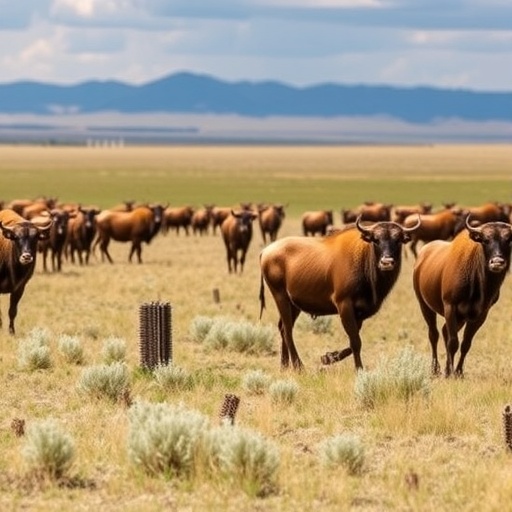ITHACA, N.Y. — For decades, the degradation of rangelands worldwide has been primarily attributed to overgrazing, prompting policies that impose herd-size limits or livestock taxes. These measures can severely restrict the economic livelihoods of herders, particularly in regions where pastoralism is a cornerstone of local culture and economy. However, a groundbreaking study conducted by researchers at Cornell University’s SC Johnson College of Business has revealed that climate change, rather than overgrazing, plays a far more critical role in driving the decline in rangeland productivity, with major implications for global land management and livestock sustainability.
The research team focused on Mongolia, a nation where rangelands cover approximately 70% of the land surface and sustain a majority of the population’s livestock. Leveraging over 40 years of detailed data, including annual livestock censuses and seasonal vegetation assessments, the study offers a comprehensive, longitudinal analysis unmatched in scale and precision. This rich dataset allowed the researchers to disentangle the relative impacts of herd sizes and climate variables on rangeland health at an administrative scale equivalent to counties, known locally as “soums.”
Central to their methodology was a sophisticated two-stage statistical model. Initially, the researchers analyzed “dzud” winter events, which are severe snowstorms causing massive livestock mortality, to predict the size of livestock herds each summer. They then used these predictions to estimate the causal effects of herd sizes and climate on the productivity of rangelands during the critical growing seasons. This approach uniquely permitted the separation of climatic influences from those of grazing pressure, which traditional correlational studies often conflated.
The study’s findings were striking. While larger herds exerted a modest negative influence on primary productivity in the short term, these effects were negligible over longer periods spanning decades. In contrast, both year-to-year weather variability and longer-term climate trends wielded profound impacts on vegetation growth and ecosystem function. Remarkably, even interannual weather fluctuations demonstrated effects approximately twenty times greater than those attributable to herd size variations.
This magnified sensitivity of rangeland ecosystems to climate factors over grazing pressure challenges prevailing management paradigms that prioritize herd reduction as the primary strategy for combating land degradation. As the lead author, Professor Chris Barrett, emphasized, “Long-term shifts in rangeland conditions across Mongolia are almost entirely a function of climatic changes rather than local herding practices.” His team’s research underscores that the most significant threats to rangeland productivity are the cumulative consequences of global greenhouse gas emissions, which drive temperature rises, altered precipitation patterns, and increased environmental volatility.
Importantly, the findings have immediate policy relevance. Mongolia’s government reinstated a nation-wide livestock head tax in 2021, aimed at curbing perceived overgrazing impacts through economic incentives to reduce herd sizes. However, Barrett and his colleagues argue that such measures unjustly penalize Mongolian herders who contribute minimally to global emissions, while the larger drivers of rangeland degradation—climate change induced by global emissions—remain unaddressed. The study advocates for a paradigm shift toward global emissions mitigation efforts coupled with international frameworks to compensate nations like Mongolia for the climate-related damages impacting their pastoral lands.
The comprehensive data collection underpinning this analysis is noteworthy. Each year, Mongolia conducts an exhaustive census of all livestock, capturing herd demographics with remarkable accuracy. In addition, during the growing season each June, detailed surveys of rangeland vegetation are performed to quantitatively assess biomass and primary productivity. By integrating these datasets across four decades, the researchers constructed multi-year climate averages and compared trends over ten- and twenty-year intervals to isolate climate impacts from the noise of short-term weather variability.
Moreover, the study’s use of dzud events as a natural experiment allowed precise estimation of causal relationships. Dzuds, which periodically cause catastrophic livestock mortality, serve as exogenous shocks to herd sizes independent of herders’ decisions. This fortuitous environmental phenomenon provided the statistical leverage to distinguish the genuine effects of herd density from those arising due to climate variability, significantly enhancing the robustness of the conclusions.
The implications of this research extend far beyond Mongolia. With more than half of Earth’s terrestrial land surface comprising rangelands, which feed roughly half of global livestock populations and sustain over two billion people, understanding the drivers of rangeland health is vital for global food security and ecosystem conservation. The indication that climate change dwarfs grazing pressure in influencing productivity prompts a reevaluation of land management and pastoral policies worldwide.
Scientifically, this study bridges economics, environmental science, and climatology, illustrating how interdisciplinary approaches are essential to untangle complex ecological phenomena. It highlights the necessity for granular, longitudinal data collection combined with innovative statistical techniques to move beyond simplistic cause-effect assumptions that have historically shaped policy decisions.
Looking forward, the researchers stress the urgency of integrating climate adaptation strategies into rangeland management, including the development of drought-resistant forage species and sustainable grazing practices that are resilient to increasing climatic extremes. At the same time, international cooperation is imperative to curb greenhouse gas emissions and equitably share the burden of mitigating climate impacts borne disproportionately by vulnerable pastoral communities.
In sum, the Cornell study revolutionizes our understanding of rangeland dynamics by providing compelling evidence that climate change is the predominant force reshaping primary productivity, overshadowing the role of local grazing pressures. This insight demands a fundamental reassessment of conservation priorities and policy frameworks to ensure the sustainable stewardship of rangelands in a warming world.
–––––––––––––––––––––––––––––––––––––––––––––––––––––––––––––––––––––––––––––––––––––––
Subject of Research:
Climate change impact on rangeland primary productivity in Mongolia
Article Title:
Climate rather than overgrazing explains most rangeland primary productivity change in Mongolia
News Publication Date:
18-Sep-2025
Web References:
https://news.cornell.edu/stories/2025/09/warming-climate-not-herd-size-biggest-threat-rangelands
http://dx.doi.org/10.1126/science.adn0005
References:
Barrett, C. et al. (2025). Climate rather than overgrazing explains most rangeland primary productivity change in Mongolia. Science. DOI: 10.1126/science.adn0005
Keywords:
Climate change, Rangeland productivity, Mongolia, Overgrazing, Pastoralism, Dzud events, Livestock management, Greenhouse gas emissions, Environmental economics, Ecosystem resilience, Primary productivity, Global land use




